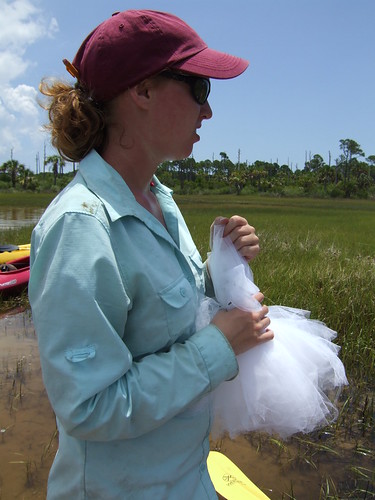Emily Field FSU Coastal & Marine Lab

Emily holds a net that will soon be full of marsh bugs. Later, at the lab, she will identify the many insect species that live amongst fiddlers and periwinkles, species more often associated with the habitat.
Several weeks ago, I went to Houston to meet Thomas Decker, a tech in Steve Pennings’ lab at the University of Houston. Thomas graciously offered up his time to help me with my insect identifications. I have absolutely zero background in entomology, the study of bugs and other creepy crawlies most people squirm about. So how did I end up spending hours puzzling through an identification book on insects, a book with so many unfamiliar terms that I was constantly flipping to the glossary and various diagrams? Silly me, I decided that I needed to include the terrestrial part of my salt marsh community. Which meant I have spent quite a bit of one-on-one time with a dichotomous key on insects. A dichotomous key is a “choose your own adventure” style guide to identification.
Here’s an example I made up for dogs on the plane back from Houston (disclaimer: this is not intended to be an accurate key):
1. Long, barrel-shaped body……………….. go to 3
2. Body otherwise shaped………………….. go to 9
3. Has a long snout……………………. Go to 5
4. Has a short snout………………………go to 15
5. Long legs……………………………….. go to 20
6. Short legged………………………….……… go to 7
7. Has floppy ears………………………Basset Hound, see pg 20
8. Ears stand upright…………………Corgy, see pg 30
In each pair, its either one option or the other, and they lead to different places.
Except that with insects, its more like “has 3 hairs on second tarsus of third appendage…”
Well, eventually I told Randall that I needed help, and she graciously contacted Steve Pennings and offered to send me to Houston. After all, most people don’t learn to ID critters from a book anyways. Most folks learn certain identifying characteristics to look for to supplement the complex and long dichotomous keys. It also helps to know that you’re not totally off base, or missing some key differences. You only improve your species identification skills by spending lots and lots of time looking at samples and comparing them to each other, to pictures online, to diagrams, and to the descriptions in the key. Which is why meeting someone who has already put in much of the difficult work of staring through a scope at minute differences is such a help. I needed a leg-up.
And my trip to Houston was just that! I was able to confirm that I have in fact been identifying some groups correctly that I was uncertain about (yay!), get helpful cues for telling some closely related specimens apart, and get practice identifying samples with someone right there to check and make sure I’m right. And all this in less than 24 hours! (I left on a Wednesday and had to be back in time for class Friday morning. ) It may have been a whirlwind of a trip, but it was absolutely worth it. I feel much more optimistic about my identification abilities, and Thomas sent me a power point full of pictures taken with their microscope camera (ooh, ahh) and key characteristics to look for, so I can look back at what I learned Houston.

Prokelisia (leafhopper), the most common insect in St Joe Bay marshes right now. Photo by Brittany McCall.
So while I don’t plan to become a jet-setter any times soon (less than a day in one place is kind of dizzying), I am pleased I took the time to go to Houston.
Emily is a graduate student working in Dr. Randall Hughes’ lab.


